how to make skin color paint
Creating the right natural tones when painting can be challenging, especially if you are a portrait artist. Understanding colors and how they blend is one of the most important things you will need to learn in order to become a good artist. When it comes to painting skin tones, this can be even more challenging as skin tones require a bit of subtlety and discovering just how to mix the right amount of paint to get it right. There are always techniques you can learn that will help guide you in the right direction to get that perfect flesh color you are looking for. So, let us move forward and discover how to make skin color paint.
Inhaltsverzeichnis
- 1 Your First Steps in Painting Skin Tones
- 1.1 Deciding on the Flesh Tone
- 1.2 Generating a Family of Flesh Tones
- 2 How to Make Skin Color with Paint
- 2.1 How to Make Skin Color with Acrylic Paint
- 2.2 How to Make Skin Color Paint with Oil Paints
- 2.3 How to Make Skin Color with Watercolor Paints
- 3 Painting Skin Tones
- 3.1 Blending Dark Flesh Tone Colors
- 3.2 Blending Light Flesh Tone Colors
- 3.3 Blending Medium Flesh Tone Colors
- 3.4 Contrasting Flesh Tone
- 3.5 Blush Flesh Tone
- 3.6 Flesh Tone and Light
- 4 Tips for Painting Skin Tones
- 5 Frequently Asked Questions
- 5.1 How Is a Darker Flesh Tone Created?
- 5.2 How Is a Beige Color Achieved?
- 5.3 How Do You Make Skin Color?
- 5.4 What Oil Paint Colors Make Flesh Color?
Your First Steps in Painting Skin Tones
Do not dip your paintbrush just yet, as there are one or two things you need to consider before you can begin painting. There are a few considerations that need to be taken before you can begin to mix your flesh color. To ensure that you blend the skin color properly, you should take a look at the following.
Deciding on the Flesh Tone
You will need to have a look at a color mixing chart for acrylic paint to get a better idea of what you want. You will notice that the skin color mixing chart has a large variety of flesh color tones and shades. There is the basic idea of light, medium, or dark, but then there is a multitude of undertones as well.
When deciding on a flesh tone, this can include some out-of-the-ordinary colors like blue. You will need to fully understand the tones and underlying colors or shades before starting. You will be amazed at the number of different colors that go into painting skin tones.
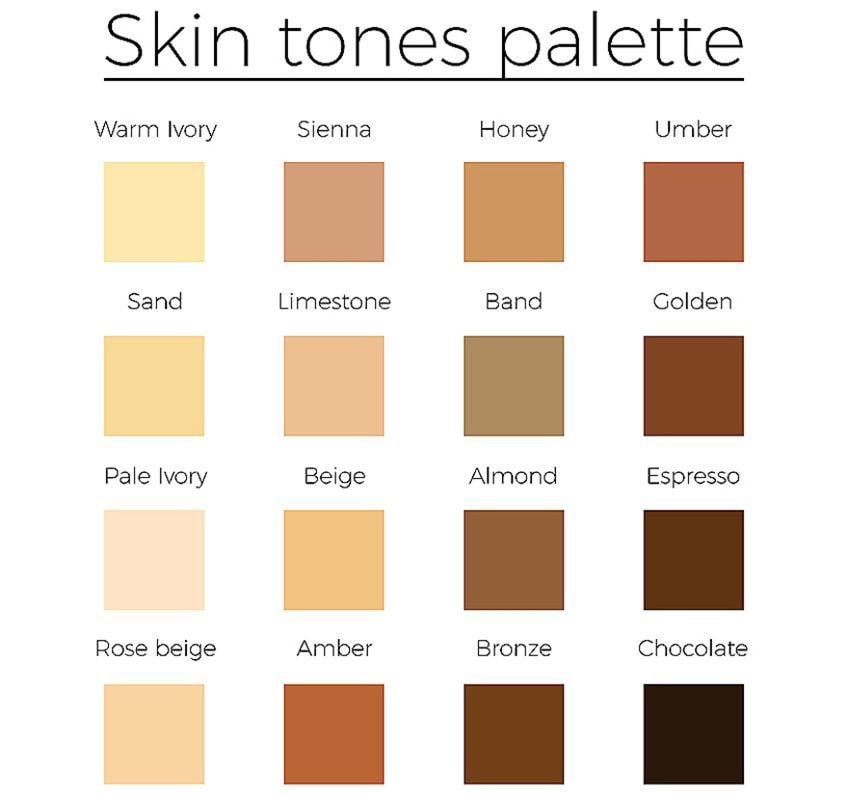
Generating a Family of Flesh Tones
Now that you have decided on a foundation skin tone, you should consider creating a family of flesh tones. To lighten the color or make it darker, you can blend in a little yellow paint, maybe including some red or blue. You can take the same flesh tone and add a variety of colors to accentuate the flesh color. When you have created a wider choice of tones, you can then easily paint a more detailed art piece.
How to Make Skin Color with Paint
Creating the perfect flesh color is a technique that may vary a little when using different mediums. Each paint medium reacts differently when you blend them, and therefore, there are different techniques used. When painting skin tones, you want to get as close as possible to the shade and tone you want. To do this, you will need to understand the properties of the type of paint you are using.
How to Make Skin Color with Acrylic Paint
How to make skin color with acrylic paint is not simple, as the acrylic paints tend to become darker when they dry. So, it is a good idea to create a slightly lighter color before it dries to achieve your desired color. When using acrylic paint, it can be difficult to re-create the exact color a second time around. When a large amount of paint is needed, it might be a good idea to mix a large batch. You can also make notes on the amounts of paint you used the first time to be able to replicate the color again. Use caution when mixing in black, as it can make the paint a muddy color when blended with other paints.
So, we recommend you use black carefully. Black color can be added easily but removing it or changing the color after adding it is nearly impossible.
The color mixing chart for acrylic paint is extensive and originates from only three colors. To mix acrylic paints, it is best to start with the primary colors. Take your palette and place a few blobs of paint close to each other. One blob of blue, red, and yellow as well as white. Then blend in an even amount of each paint and this should make a darker shade of brown. This forms the base for your flesh color.
This is the foundation from which you can then adjust the color to create a more specific tone. Lightening a color is usually easier than making it darker, which is why a darker foundation color is best. To lighten the tone, you can simply mix in some white paint, or you can include some primary colors for more of an accented color. Adding blue creates a darker shade while red gives a blush and yellow also lightens or brightens a color. Experiment with all the colors until you reach the desired flesh tone.
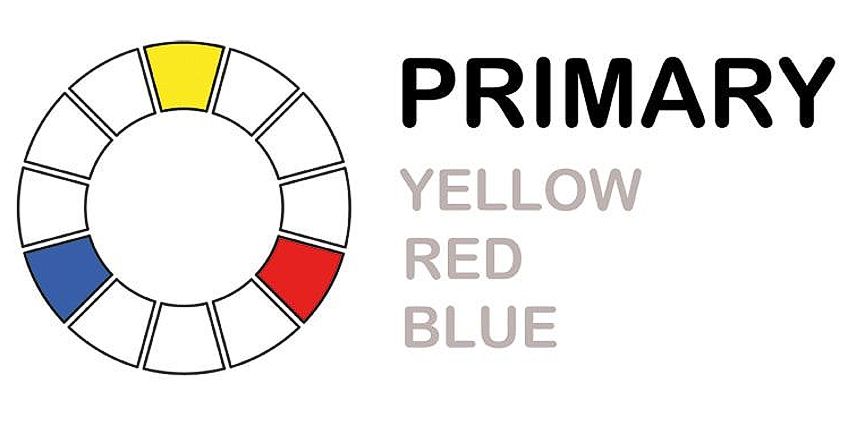
How to Make Skin Color Paint with Oil Paints
There are many oil paint colors you can choose, which makes it easier to create many tones and shades of flesh color. Simply follow the same steps as when mixing acrylic paints. However, you can also begin with a vermillion red hue and blend in some yellow ochre. You will then get an orange shade. Next, blend in a little ultramarine blue to add depth and also to darken the color. Finally, mix in some titanium white to reach a nice general skin tone. You can then add your primary colors in different amounts to reach the flesh tone you want.
You can follow another route by starting with green as the foundation. Green can be created by blending blue and yellow. Enhance this by mixing in a little red or orange to lighten it. You can then either darken the color by adding blue or lighten it by adding a little white. Experiment until you reach the color you want; there are no set rules when it comes to creating unique art pieces.
How to Make Skin Color with Watercolor Paints
When compared to acrylic paints, watercolors dry lighter than they are before painting. So, it might a good idea to paint a color tone slightly darker, as it will lighten as it dries. When using white and black watercolors, you need to be careful as black can turn your color muddy. White, on the other hand, will make the color more translucent. Rather use brown paint to darken any colors you want to use.
To create your watercolor skin tone foundation, you need to use red, yellow, and blue. Begin using mostly yellow, then include a small amount of red and then only a drop of blue. This should give you an orange-brown shade that you can then work with.
Change the tone and shade by mixing in small quantities of red, yellow, and blue, and maybe green. You will need to be careful when mixing watercolors, as you only need small amounts to make a change. Again, experiment until you find the skin tone and color you are looking for. You can then create different variations of color that can add to the paint effect you want.
When using watercolors, you might want to have a test paper handy in order to test out your blended colors before applying it to your final art piece. Watercolor paints dry fast, so you will be able to see what happens fairly quickly. You can then move onto painting or try another color.
Painting Skin Tones
How to make skin color with paint can be challenging, as there is such a wide range of skin tones. However, you can categorize the general shades into three main groups: dark, medium, and light. Using these as your foundation, you can then branch out and create varying tones and effects.
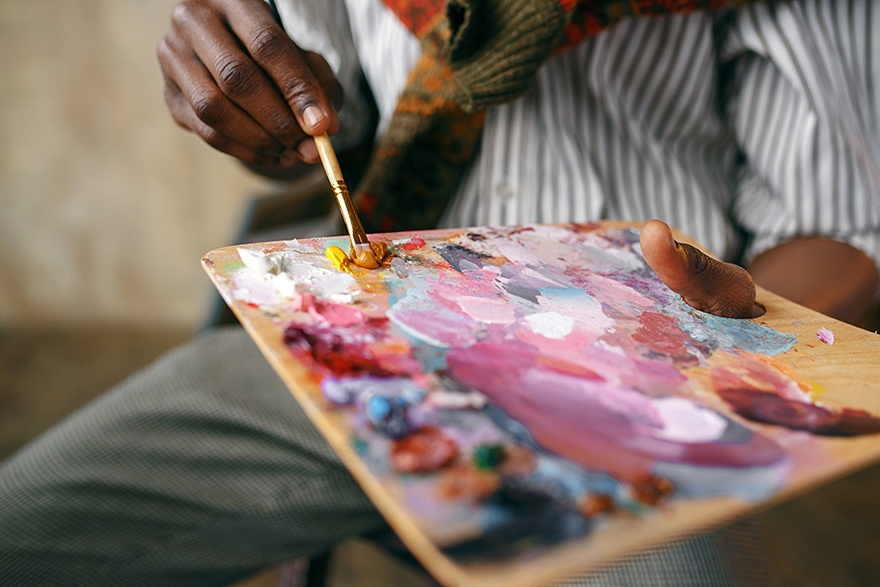
Blending Dark Flesh Tone Colors
Creating darker tones can be difficult but experimenting and playing around with the colors should give you an idea of how things work. You can start with using purple, yellow, red, raw sienna, and burnt umber. Place equal amounts of burnt umber and raw sienna onto your palette and this will be your first foundation.
You can then blend equal amounts of red and yellow for your second foundation color. Take a little paint from both of these foundation colors to create the base you will be working from. From here, you can then begin to play with colors so as to create different tones and details. For example, you can mix in a little purple for a darker color and create more depth.
Do not mix in black, as this could muddy your color. A better color to use would be gray. Add yellow and red for blush and highlights. There is an endless choice of color variations, so it can be quite challenging to get just the right color you are looking for. Always mix in small amounts of color and create as many skin tones as possible, so that you can have a wide range to work with.
Blending Light Flesh Tone Colors
This works similar to how to make skin color with acrylic paint. You begin with equal amounts of red, blue, and yellow. To lighten, you can then use white or yellow. To create a lighter flesh tone, you can include quite a bit of white into the mix. Including various amounts of yellow and red will give you a blush tone or a tan skin tone. Adding blue darkens the tone, so you only need a little for effect.
Blending Medium Flesh Tone Colors
Creating a medium skin tone requires quite a few color variations. You will need to use more paint and create more combinations to reach the desired result. When consulting the skin color mixing chart, you can add raw sienna and burnt umber into the mix.
Begin by combining yellow and red, which then creates an orange color. You can then slowly add blue to change the tone but remember to use small amounts of color, as you cannot take out the darker blue color. For a darker skin tone, you can consider using an extremely small amount of black paint.
The correct flesh tone all depends on the changes you make that create highlights and details. Mix the burnt umber and raw sienna and add them to the mix to create a darker shade. This variation can be used instead of blue, giving you an olive shade. You can also try a little green to enhance the color. Play around and experiment further, adding yellow, red, and olive variations to create the shade you are looking for. Creating highlights for medium skin tones works best when using yellow and not white.
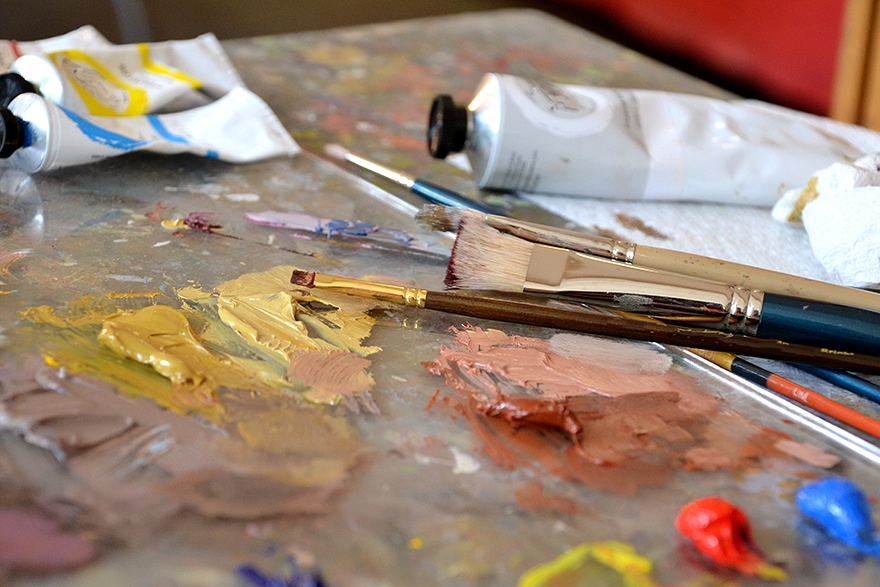
Contrasting Flesh Tone
There is never just one shade of color; a single person can have many variations in skin tone. You have to think of things like shadows, light, and blush. You need to think about all these things to be able to create realistic paintings. When discovering how to make skin color paint, you need to make sure that you have at least several variations of each chosen color.
Blush Flesh Tone
The basics of making the perfect flesh tone will begin with creating your foundation or base color and then blending several variations around this. One of the effects or tones to consider is a blush. Think rosy cheeks or sunlight hitting the body. To create this, you need to blend small quantities of white, red, or yellow into your color variations. Never simply add red or pink directly to your painting, as the color has to be more subtle and unique than this.
Flesh Tone and Light
The flesh color can be changed by differing light effects. The right shade of color depends on the amount of shadow in the painting. For this, you need to mix more variations of darker and lighter shades from the base color. Darker colors are reached by including purple, blue, or sometimes gray, and light colors need white or yellow. Adding black is tricky, so be careful when adding this color.
When using acrylic paints, it is best to start with a base color. Then you can create variations by including small amounts of the primary colors. For example, take your base color and add blue, red, or yellow. You can then work from there to create various light-tinged skin tones.
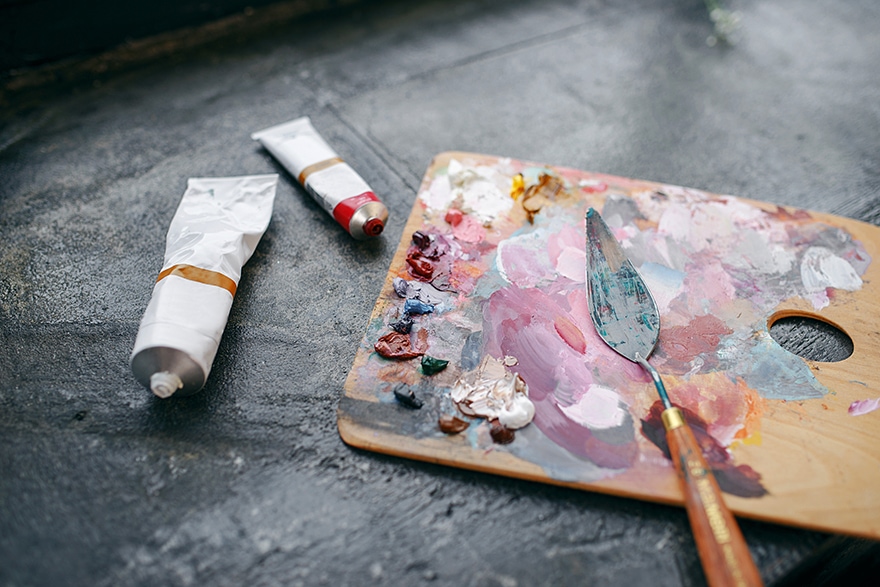
Tips for Painting Skin Tones
As with any art form, it is always helpful to know a few tips to make things easier. So, here are a few helpful ideas you can use to make your painting experience a smoother one.
- When painting, there is more than one skin tone for each person, so you should always make several variations to fill in all the details.
- Place an actual photo of the skin color you want next to you while you work.
- Keep some test paper around so that you can test out the paint color first, as some paints tend to dry darker or lighter.
- Try not to use black; we recommend you rather use a purple or blue for darker shades.
- Darkening a color is tricky, so always use small amounts of color and be careful. A darker tone is easy to create but reversing the effect is difficult.
How to make skin color with paint is a difficult subject for many artists. But it does not have to be difficult – all you need is some understanding of color mixing and time to experiment with the paint colors. Use a skin color mixing chart and follow the basic concepts and you will be painting skin tones in no time.
Frequently Asked Questions
How Is a Darker Flesh Tone Created?
The best way to create darker flesh tones is to mix in purple or blue colors, as adding black might create a muddy color.
How Is a Beige Color Achieved?
As with any color, you can create several variations of beige. However, a simple beige color can be achieved by combining brown and white, or gray. You can also mix in yellow for a different tone. Brown is a blend of blue, red, and yellow.
How Do You Make Skin Color?
When looking at the skin color mixing chart, you will notice that you need the three primary colors of red, yellow, and blue. To this you must add a little white, which will create a foundation or base to work from in order to create variations in skin tone.
What Oil Paint Colors Make Flesh Color?
When you are using oil paints, you must have red, yellow, and blue, and then white for different flesh color tones. You can also add various shades of green, brown, or orange for more effects.
how to make skin color paint
Source: https://fluid-painting.com/en/how-to-make-skin-color/
Posted by: hillsomprood.blogspot.com

0 Response to "how to make skin color paint"
Post a Comment